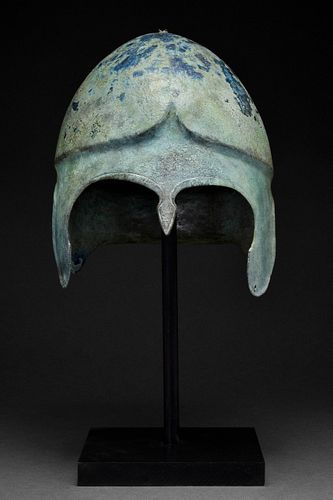AN EARLY GREEK CHALCIDIAN HOPLITE BRONZE HELMET
Lot 216
Categories
Estimate:
GBP£45,000 - GBP£85,000
$57,692.31 - $108,974.36
Absentee vs Live bid
Two ways to bid:
- Leave a max absentee bid and the platform will bid on your behalf up to your maximum bid during the live auction.
- Bid live during the auction and your bids will be submitted real-time to the auctioneer.
Bid Increments
| Price | Bid Increment |
|---|---|
| GBP£0 | GBP£10 |
| GBP£100 | GBP£10 |
| GBP£200 | GBP£20 |
| GBP£500 | GBP£50 |
| GBP£1,000 | GBP£100 |
| GBP£2,000 | GBP£200 |
| GBP£5,000 | GBP£500 |
| GBP£10,000 | GBP£1,000 |
| GBP£20,000 | GBP£2,000 |
| GBP£50,000 | GBP£5,000 |
| GBP£100,000 | GBP£10,000 |
| GBP£200,000 | GBP£20,000 |
| GBP£1,000,000 | GBP£50,000 |
About Auction
By Apollo Art Auctions
Jan 16, 2022
Set Reminder
2022-01-16 08:00:00
2022-01-16 08:00:00
America/New_York
Bidsquare
Bidsquare : Ancient Art & Antiquities
https://www.bidsquare.com/auctions/apollo-art-auctions/ancient-art-antiquities-8043
Apollo Art Auctions enquiries@apolloauctions.com
Apollo Art Auctions enquiries@apolloauctions.com
- Lot Description
Circa 550 - 450 BC. A very expressive form of bronze helmet of early Chalcidian type with deep crescentic cheek-guards with single hole, a small tear-drop shaped nose guard, eyes carefully cut out, eyebrows in ridged relief, sharply carinated and crested crown, a flaring neck guard. Museum Quality helmet. Nicely patination finish remaining. Cf. Antike Helme, pp. 139-141, for a discussion of the type (Chalcidian II) characterized by the eyes cut deeply into the rounded cheek-guards. For related examples also see Sotheby's, New York, December 8th, 2000, nos. 61-62. For similar see Sotheby?s, lot 68, 7th December 2001. The Metropolitan Museum of Fine Art, Accession no. 2003.407.2 Vogel, Carol. April 4, 1993. "Home Design." New York Times Magazine, : pp. 20?21. Blass, Bill. 2002. Bare Blass, Cathy Horyn, ed. p. 136, New York: HarperCollins. Milleker, Elizabeth J. and Dr. Se?n Hemingway. 2004. "Recent Acquisitions: A Selection 2003?2004." Bulletin of the Metropolitan Museum of Art, 62(2): p. 7. Metropolitan Museum of Art. 2004. "One Hundred Thirty-fourth Annual Report of the Trustees for the Fiscal Year July 1, 2003 through June 30, 2004." Annual Report of the Trustees of the Metropolitan Museum of Art, 134: p. 19. Chalcidian helmets are named after similar helmets depicted on pottery vases from the Euboean city of Chalcis. This type of ancient Greek helmet was a lighter and less restrictive form of the Corinthian helmet. By the time of Alexander the Great the helmet was still worn by soldiers, most notably the hoplites, the heavy infantrymen who carried long spears; the helmet would later go on to develop into the Attic helmet which is iconic of Classical soldiers. Size: L:210mm / W:225mm ; 700g. Provenance: From a collection of Roman & Greek arms and armour formed in the late 1970s and early 1980s; property of a London gentleman.
- Shipping Info
-
We offer in-house packing and international shipping at discounted rates.
-
- Buyer's Premium



 EUR
EUR CAD
CAD AUD
AUD GBP
GBP MXN
MXN HKD
HKD CNY
CNY MYR
MYR SEK
SEK SGD
SGD CHF
CHF THB
THB


















